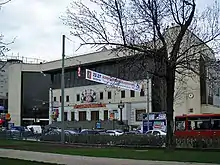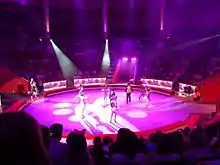Moscow Circus on Tsvetnoy Boulevard
Moscow Circus on Tsvetnoi Boulevard, or Nikulin's Circus, is located on Tsvetnoi Boulevard in the Tverskoy District of central Moscow. It was the only circus in the city between 1926 and 1971, and still remains the most popular one.

History
Salamonsky Circus
The circus was established by Albert Salamonsky, descended from a family of Jewish circus riders. He constructed the circus building in Moscow on a place where usually travelling shows and vagarious artists performed at fairs. The very first performance was on October 12, 1880. Salamonsky was an innovative enterpreneur — he included non-circus artists like singers, choruses, folk ensembles, he staged shows with 35 riders in the ring and organized first Christmas shows for kids. Salamonsky also strived to make circus art be more accessible, he introduced cheaper rows and standees.[1]
Upon his death in 1913, the popularity of the circus decreased.[1]
Soviet Circus
After the Russian revolution, in 1919 the circus was nationalized by the Soviet Government. The Bolsheviks saw the circus art as a very important tool of mass propaganda and tried to ‘revolutionize’ the repertoire. Only in the 1930s the artists managed to deprive the shows from propaganda. In 1945 Nikolay Baikalov was assigned to the director’s post, his epoch in the Tsvetnoy became one of the most important parts in the circus’s history.[1]
The troupe was awarded the Order of Lenin in 1939.[2]
Since the middle of XX century the soviet circus was considered the most professional in the world, it toured a lot and gained wide recognition. In the USSR all circuses were subordinate to the GouzGodTsirk (Soviet State Circus) Department, and all the artists were officially hired as its employees.[3]
Among the famous performers who worked there were clowns Karandash, Oleg Popov, Leonid Yengibarov and Yuri Nikulin, illusionist Emil Kio, performer Margarita Nazarova, the Durovs, Yuri Kuklachyov, etc.[4]
Nikulin's Circus
Yuri Nikulin, one of the most popular clowns in Russia and successful cinema actor, worked for the Tsvetnoy circus for 33 years. In 1981 he retired from performing and was assigned to the director's post. Nikulin managed the circus for fifteen years.[5][6] During his office the company managed to survive through the crisis in the 1990s, when the country faced a political and economical collapse.[7][8] He 'cleaned' the repertoire from Soviet propaganda heritage and welcomed the spirit of new age into the shows.[9]
The circus has borne Nikulin's name since his death in 1997. In front of the building is a remarkable statue of Nikulin, whose son has managed the circus since his death. Valentin Gneushev was the circus choreographer in the late 1990s.
See also

- Bolshoi Circus on Vernadsky Prospekt
- Ciniselli Circus in Saint Petersburg
References
- "Коренной москвич с Цветного бульвара" [Moscow Native from Tsvetnoy Boulevard] (in Russian). Culture. Retrieved 2020-12-04.
- "About the Old Moscow Circus on Tsvetnoy Boulevard". Московский Цирк Никулина на Цветном Бульваре. Archived from the original on 13 November 2014. Retrieved 13 November 2014.
- "Три эпохи на Цветном: цирк празднует день рождения" [Three Epochs on Tsvetnoy: Circus Celebrates Anniversary] (in Russian). Izvestiya. 2016-10-20. Retrieved 2020-12-04.
- "Nikulin Moscow Circus on Tsvetnoy Boulevard". Moscow International Portal. Department of Foreign Economic and International Relations of the City of Moscow. Retrieved 13 November 2014.
- nevil, D. (1997-08-22). "Obituary: Yuri Nikulin". The Independent. Retrieved 2020-12-03.
- "95 лет со дня рождения Юрия Никулина" [95 Years since Yuri Nikulin Birthday] (in Russian). Kultura Channel. 2016-12-18. Retrieved 2020-12-04.
- Skoblo, S., Butuzova, P., Sakharova, K. (1998-11-30). "Цирк горит, директоров - отстреливают" [Circus Burns, Directors Hunted] (in Russian). Moskovsky Komsomolets. Retrieved 2020-12-04.CS1 maint: multiple names: authors list (link)
- "Yuri Nikulin". The Economist. 1997-08-28. Retrieved 2020-12-03.
- Stites 1992, p. 182-183.
Literature
- Stites, Richard (1992). Russian Popular Culture: Entertainment and Society Since 1900. Cambridge: Cambridge University Press. p. 182-183. ISBN 0-521-36986-X.CS1 maint: ref=harv (link)
External links
- The official site of the Moscow Circus on Tsvetnoy Boulevard.
